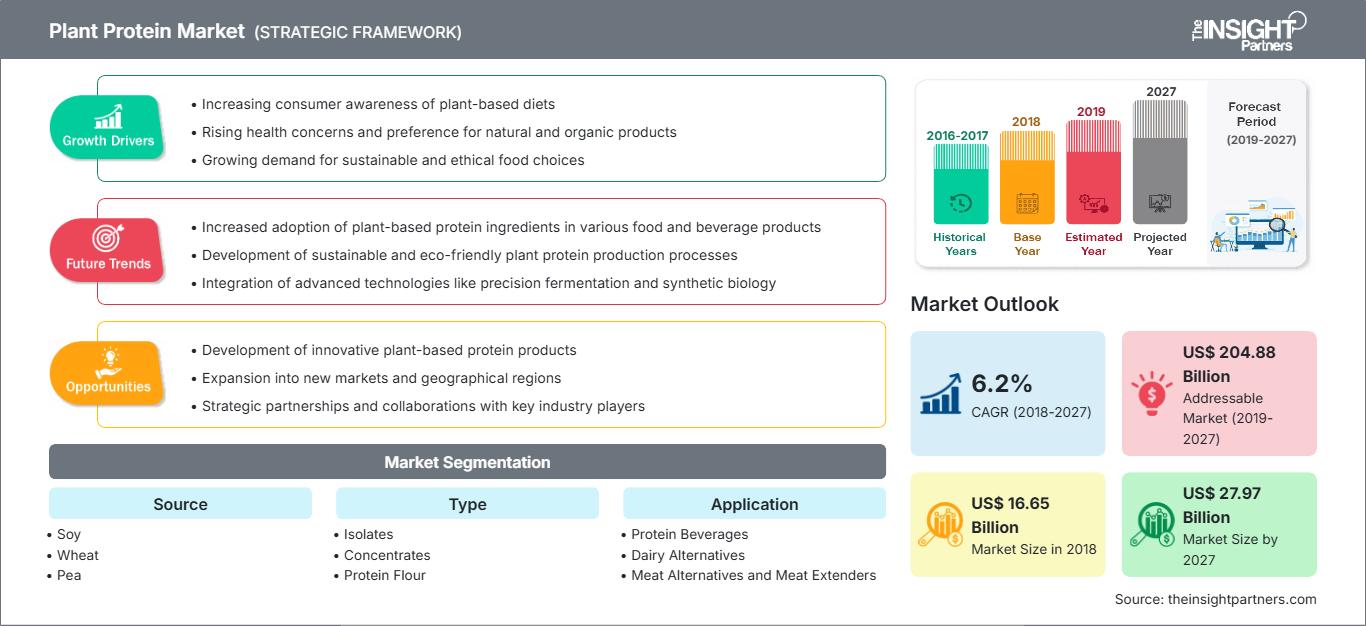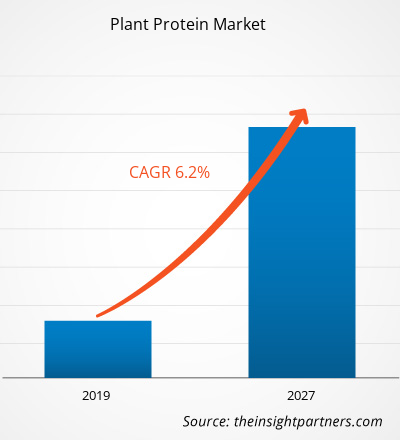植物性タンパク質市場は2018年に166億5,360万米ドルと評価され、2027年には279億6,590万米ドルに達すると予測されています。また、2019年から2027年にかけて6.2%のCAGRで成長すると見込まれています。
タンパク質は人体に必要な重要な栄養素であり、アミノ酸で構成されています。植物性タンパク質は、大豆、小麦、エンドウ豆、ナッツ、種子など、さまざまな植物源から得られます。レンズ豆、ひよこ豆、ピーナッツ、アーモンド、スピルリナ、キヌア、チアシードなど、さまざまな植物源が大量のタンパク質を提供します。植物性タンパク質はカロリーが低いため、減量のために動物性タンパク質の代替として摂取できます。植物性食品の需要増加と高タンパク食品への消費者の関心の高まりが相まって、植物性タンパク質市場の成長を世界的に押し上げる主な要因となっています。
アジア太平洋地域(APAC)の植物性タンパク質市場は、予測期間中に最も高いCAGRで成長すると予想されています。この地域の植物性タンパク質市場の成長は、主に可処分所得の増加に起因しており、ライフスタイルの変化がアジア太平洋地域における植物性タンパク質の主要な推進要因となっています。中国、インド、日本などのアジアの先進国および発展途上国における食品・飲料業界の急速な成長は、植物性タンパク質がプロテイン飲料、乳製品代替品、肉代替品、プロテインバーなどの製品に広く使用されているため、植物性タンパク質メーカーにとって巨大な市場機会を提供しています。
インド、中国、オーストラリアなどの先進国および発展途上国の人々の可処分所得の増加は、この地域における植物性タンパク質の大きな需要につながっています。
要件に合わせてレポートをカスタマイズ
レポートの一部、国レベルの分析、Excelデータパックなどを含め、スタートアップ&大学向けに特別オファーや割引もご利用いただけます(無償)
植物性タンパク質市場: 戦略的洞察

-
このレポートの主要な市場動向を入手してください。この無料サンプルには、市場動向から見積もりや予測に至るまでのデータ分析が含まれます。
市場インサイト:高タンパク質食品に対する消費者意識の高まりが植物性タンパク質市場の成長を促進
タンパク質は、細胞の修復を助け、ウイルスや細菌から体を守ることで、分子を体全体に運ぶ上で重要な役割を果たします。また、子供、ティーンエイジャー、妊婦の適切な成長と発達を促進します。
様々な研究によると、高タンパク質の食事を摂取すると、筋肉量と筋力が増加し、体重管理や減量プログラム中の筋肉の減少を防ぐのに役立つことが示されています。
タンパク質を多く摂取する人は、骨量を維持する傾向があり、骨粗鬆症や骨折のリスクが大幅に低くなります。高タンパク質摂取は代謝を促進し、大量のカロリーを燃焼させます。これは、適切な体重管理と減量にも役立ちます。タンパク質のこれらの利点は、市場で入手可能な高タンパク質食品や飲料への消費者の関心を高めています。これにより、世界中で植物性タンパク質への大きな需要が生まれています。
高タンパク質食品は、食品・飲料業界における最も強力なトレンドの一つと考えられています。食品におけるタンパク質のトレンドを受けて、食品・飲料メーカーは栄養食品の製造に取り組んでいます。タンパク質を豊富に含む食品の摂取を通じて減量、アンチエイジング、その他の健康関連の問題を効果的に解決する方法に関する消費者意識の高まりが、植物性タンパク質の需要を押し上げています。さらに、健康とウェルネスのトレンドの高まりにより、機能性食品や強化飲料への需要が過去数年間で大幅に高まっています。したがって、タンパク質を豊富に含む食品に関する消費者意識の高まりが、植物性タンパク質市場の成長を後押しすると予想されます
情報源に基づく洞察
情報源に基づいて、植物性タンパク質市場は、大豆、小麦、エンドウ豆、その他に分類されます。大豆セグメントは2018年に最大の市場シェアを占めましたが、エンドウ豆セグメントは予測期間中に市場で最も高いCAGRを記録すると予想されます。大豆タンパク質分離物は、タンパク質含有量が最低90%の、大豆タンパク質の高度に精製された形態です。大豆タンパク質は、脂肪や炭水化物などの非タンパク質成分のほとんどが除去された脱脂大豆粉から作られています。大豆タンパク質パウダーは、糖類と食物繊維を取り除くため、アルコールか水で洗浄された脱脂大豆フレークから作られています。その後、脱水されて粉末に粉砕されます。大豆タンパク質パウダーは、乳児用大豆粉乳や、さまざまな肉や乳製品の代替品を作るのに使われています。大豆タンパク質濃縮物は通常、70%の大豆タンパク質を含み、基本的には水溶性炭水化物を除いた脱脂大豆粉です。この形態のタンパク質は、脱殻・脱脂大豆から炭水化物の一部を取り除くことによって作られています。大豆粉は、大豆を細かい粉末に粉砕することによって作られています。
タイプ別の洞察
タイプに基づいて、植物性タンパク質市場は、分離物、濃縮物、およびタンパク質粉に分類されます。濃縮物セグメントは、2018年に最大の市場シェアを占めました。植物性タンパク質濃縮物は、大豆、小麦、エンドウ豆、キヌア、オート麦、豆、ナッツなどのさまざまな供給源からタンパク質を抽出することによって生産されます。これらは通常、60~80%のタンパク質を供給し、残りの20~40%は脂肪と炭水化物で構成されています。濃縮植物性タンパク質は、最も加工されていないタイプのプロテインパウダーです。濃縮された形の植物性タンパク質は、体にすばやく吸収されるため、激しい運動からの筋肉の迅速な回復に役立ちます。したがって、植物性タンパク質濃縮物の入手しやすさと、植物性タンパク質分離物に比べて価格が低いことが、市場を押し上げる主な要因です。植物性タンパク質濃縮物は最も安価な選択肢になる傾向がありますが、他の成分をより多く含んでいるため、植物性タンパク質分離物に比べてタンパク質の量が最も少なくなります。これらの追加成分には、脂肪、コレステロール、ラクトース、グルテンが含まれます。脂肪摂取量を制限したい、または消化器系が敏感な消費者は、植物性タンパク質濃縮物を避けるべきです。
用途別インサイト
植物性タンパク質市場は、種類別に、プロテイン飲料、乳製品代替品、肉代替品・肉増量剤、プロテインバー、ベーカリー、その他の用途に分類されます。2018年には、肉代替品・肉増量剤セグメントが最大の市場シェアを占めました。肉代替製品には、豆腐、テンペ、テクスチャード植物性タンパク質、セイタン、クォーンなどがあります。これらの製品は、鶏肉、肉、魚介類に似た味、外観、食感を備えています。穀物や植物由来の原料を使用して製造され、動物性タンパク質やミネラル(特にカルシウム)の代替として、コレステロール値の低下、更年期障害、その他の関連疾患の予防に役立ちます。植物性タンパク質は、肉代替品の製造に広く使用されています。豆類は、肉の代替品として利用できる、手頃な価格の植物性タンパク質源です。大豆は、肉代替品を生産するための主要な原料の一つでもあります。エンドウ豆タンパク質分離物は、Daiya、Gardein、Ben & Jerry's、Beyond Meat、Just Mayo、Ripple Foodsなど、肉代替品メーカーによって主に使用されています。したがって、肉代替品の需要と生産の急増は、植物性タンパク質の需要の増加につながります。消費者の健康への関心の高まりとビーガンフードの嗜好の高まりにより、肉代替品の需要は高まっています。さらに、肉や肉製品の消費による肥満レベルの上昇も、肉代替品に対する消費者の嗜好の高まりにつながっています。
植物性タンパク質市場で活動している企業としては、Archer Daniels Midland Company、Axiom Foods, Inc.、Burcon NutraScience Corporation、Cargill, Incorporated、EI Du Pont De Nemours and Company、Glanbia plc、Ingredion Incorporated、Kerry Group、Koninklijke DSM NVなどがあります。ロケット・フレールなど、主要企業は合併・買収や研究開発戦略を駆使して顧客基盤を拡大し、世界市場で大きなシェアを獲得することで、世界的なブランド力を維持しています。
植物性タンパク質市場
予測期間を通じて植物性タンパク質市場に影響を与える地域的な傾向と要因については、The Insight Partnersのアナリストが詳細に解説しています。このセクションでは、北米、ヨーロッパ、アジア太平洋、中東・アフリカ、中南米における植物性タンパク質市場のセグメントと地域についても解説しています。
植物性タンパク質市場レポートの範囲
| レポート属性 | 詳細 |
|---|---|
| の市場規模 2018 | US$ 16.65 Billion |
| 市場規模別 2027 | US$ 27.97 Billion |
| 世界的なCAGR (2018 - 2027) | 6.2% |
| 過去データ | 2016-2017 |
| 予測期間 | 2019-2027 |
| 対象セグメント |
By 原材料
|
| 対象地域と国 |
北米
|
| 市場リーダーと主要企業の概要 |
|
植物性タンパク質市場のプレーヤー密度:ビジネスダイナミクスへの影響を理解する
植物性タンパク質市場は、消費者の嗜好の変化、技術の進歩、製品の利点に対する認知度の高まりといった要因により、エンドユーザーの需要が高まり、急速に成長しています。需要の増加に伴い、企業は製品ラインナップの拡充、消費者ニーズへの対応、新たなトレンドの活用を進めており、これが市場の成長をさらに加速させています。

- 入手 植物性タンパク質市場 主要プレーヤーの概要
レポートの注目点
- 植物性タンパク質市場における業界の最新動向。企業が効果的な長期戦略を策定できるよう支援します。
- 先進国と発展途上国で採用されているビジネス成長戦略
- 2018年から2027年までの植物性タンパク質市場の定量分析
- 植物性タンパク質の世界需要の予測
- 業界で事業を展開するバイヤーとサプライヤーの有効性を示すPEST分析
- 競争の激しい市場シナリオを理解するための最近の動向
- 植物性タンパク質市場の成長を促進および抑制する要因、市場動向と展望
- 商業的関心を支え、市場の成長につながる市場戦略を強調することで、意思決定プロセスを支援します。
- さまざまなノードにおける植物性タンパク質市場の規模
- 市場と植物性タンパク質業界の詳細な概要とセグメンテーションダイナミクス
- 有望な成長機会のあるさまざまな地域における植物性タンパク質市場の規模
- 過去2年間の分析、基準年、CAGRによる予測(7年間)
- PEST分析とSWOT分析
- 市場規模価値/数量 - 世界、地域、国
- 業界と競争環境
- Excel データセット
最新レポート
お客様の声
購入理由
- 情報に基づいた意思決定
- 市場動向の理解
- 競合分析
- 顧客インサイト
- 市場予測
- リスク軽減
- 戦略計画
- 投資の正当性
- 新興市場の特定
- マーケティング戦略の強化
- 業務効率の向上
- 規制動向への対応






















 無料サンプルを入手 - 植物性タンパク質市場
無料サンプルを入手 - 植物性タンパク質市場